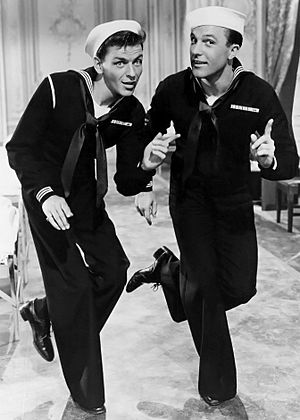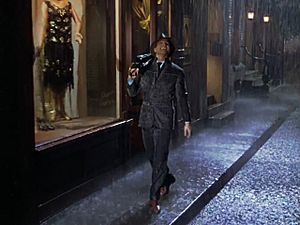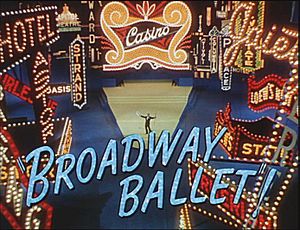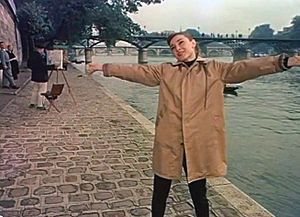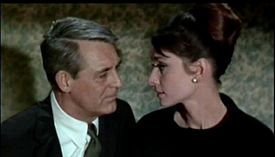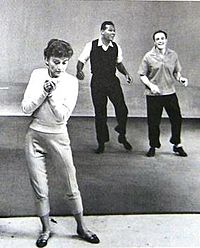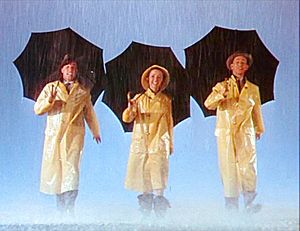Stanley Donen facts for kids
Quick facts for kids
Stanley Donen
|
|
|---|---|
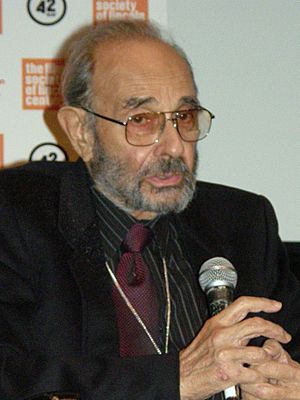
Donen in 2010
|
|
| Born | April 13, 1924 |
| Died | February 21, 2019 (aged 94) New York City, U.S.
|
| Occupation | Film director, film producer, choreographer, dancer, stage director |
| Years active | 1940–2003 |
| Known for | Singin' in the Rain, On the Town, Funny Face, Charade |
| Spouse(s) |
Jeanne Coyne
(m. 1948; div. 1951)Adelle O'Connor Beatty
(m. 1960; div. 1971)Yvette Mimieux
(m. 1972; div. 1985)Pamela Braden
(m. 1990; div. 1994) |
| Partner(s) | Elaine May (c. 1999) |
| Children | 3, including Joshua Donen |
Stanley Donen (born April 13, 1924 – died February 21, 2019) was an American film director and choreographer. This means he directed movies and created the dances for them. He is famous for directing classic movie musicals like On the Town (1949) and Singin' in the Rain (1952). He worked on both of these with the legendary dancer and actor Gene Kelly.
Donen also directed other well-known films, including Royal Wedding (1951), Seven Brides for Seven Brothers (1954), Funny Face (1957), and Charade (1963). He started his career as a dancer on Broadway, where he met Gene Kelly. Later, he moved to Hollywood to work as a choreographer.
Stanley Donen helped change how Hollywood musicals were made. Before him, many musicals looked like stage shows filmed for the big screen. Donen and Kelly made movies where the songs and dances felt like a natural part of the story. They created dances that could only be done in movies, using special camera tricks. Film experts often praise Donen for his important role in making movie musicals more creative and exciting. He received an Honorary Academy Award in 1998 for his amazing work.
Early Life and First Steps
Stanley Donen was born on April 13, 1924, in Columbia, South Carolina. His father, Mordecai Moses Donen, managed a dress shop, and his mother, Helen, was the daughter of a jewelry salesman. Stanley had a younger sister named Carla. Growing up, Donen felt a bit lonely. He was one of the few Jewish kids in his town and was sometimes bullied.
To escape his loneliness, Donen spent a lot of time at local movie theaters. He loved Westerns, comedies, and thrillers. The movie that changed everything for him was the 1933 musical Flying Down to Rio, starring Fred Astaire and Ginger Rogers. Donen watched it many, many times. He said it made him feel like he was in a happy, fantasy world. His father bought him an 8mm camera, and he started making his own home movies.
Inspired by Fred Astaire, Donen began taking dance lessons in Columbia. He performed at the local Town Theater. His family often visited New York City during summer breaks, where he saw Broadway musicals and took more dance classes. One of his early teachers in New York had even taught Fred Astaire when he was a boy!
After high school, at age sixteen, Donen studied psychology for a summer at the University of South Carolina. But his mother encouraged him to follow his dream of dancing. In the fall of 1940, he moved to New York City. After just two auditions, he was cast as a dancer in a Broadway show called Pal Joey. This show was directed by the famous George Abbott, and the main role was played by a young, rising star named Gene Kelly.
Abbott then cast Donen in his next Broadway show, Best Foot Forward. Donen became the assistant stage manager, and Kelly asked him to be his assistant choreographer. Donen later worked as a stage manager and assistant choreographer for Abbott's show Beat the Band in 1942. In 1946, Donen returned to Broadway briefly to help create dances for Call Me Mister.
Hollywood Adventures Begin
Becoming a Choreographer
In 1943, Arthur Freed, a successful producer of musical films at MGM, bought the rights to Best Foot Forward. He made a movie version of it. Donen moved to Hollywood to try out for the film and got a one-year contract with MGM. He appeared as a chorus dancer and became an assistant choreographer.
At MGM, Donen reconnected with Gene Kelly, who was now a supporting actor in musicals. When Kelly got a chance to choreograph his own dances for a film at Columbia Pictures, he asked Donen to help him. Donen agreed and helped create three dance scenes with Kelly in Cover Girl (1944). Donen came up with the idea for the "Alter Ego" dance, where Kelly's reflection dances with him. The director didn't think it would work, so Donen and Kelly directed the scene themselves. Donen spent over a year editing it. This film made Kelly a movie star and was seen as a very new and exciting musical. Donen then signed a contract with Columbia, choreographing several films there. He returned to MGM the next year when Kelly needed his help again.
In 1944, Donen and Kelly choreographed the musical Anchors Aweigh, released in 1945. It starred Kelly and Frank Sinatra. This film is famous for a scene where Kelly dances with Jerry Mouse from the Tom and Jerry cartoons. This was one of the first times a real person danced with a cartoon character in a movie! Donen and Kelly had wanted to use Mickey Mouse or Donald Duck, but Walt Disney was working on his own similar idea. Donen and Kelly spent two months filming Kelly dancing, and Donen spent a year making the scene perfect, frame by frame.
While Kelly was serving in the United States Navy from 1944 to 1946, Donen worked as an uncredited choreographer on other musical films. He said he was learning his craft, working with music, sound, and cameras. He often directed the dance parts. Donen was excused from military service due to high blood pressure. When Kelly returned, he and Donen directed and choreographed Kelly's dance scenes in Living in a Big Way (1947). They then started working on a story about two baseball players who become song and dance men. This became Take Me Out to the Ball Game (1949). Donen and Kelly wanted to direct the whole film, but the producer hired another director. They only directed Kelly's dance numbers. The film starred Kelly, Frank Sinatra, and Jules Munshin.
Directing On the Town
After the success of Take Me Out to the Ball Game, producer Arthur Freed gave Donen and Kelly the chance to direct On the Town. It came out in 1949. This movie was based on a Broadway musical about sailors on leave in New York City. It was one of the first musicals to film scenes in real places, not just on a studio set. Donen and Kelly wanted to film the whole movie in New York, but they were only allowed one week there.
That week, they filmed the opening song, "New York, New York". Away from the studio, Donen and his camera team filmed on the streets of New York City. They used new camera tricks like quick cuts, spinning camera shots, hidden cameras, and sudden changes in direction. These techniques would later be used by other famous directors. Film experts say this scene was a turning point for musicals. It was the first musical to truly use the city as a character and to move dance out of the theater and into the film itself.
On the Town starred Kelly, Frank Sinatra, and Jules Munshin as three sailors exploring New York. They meet and fall in love with three women played by Ann Miller, Betty Garrett, and Vera-Ellen. The movie was a big hit and won an Academy Award for its music. Donen was only 25 when he directed his first movie. Donen said Kelly was mostly in charge of the dance moves, while he focused on the camera work for both the acting and musical scenes. Kelly felt they were a good team and helped each other.
Becoming a Solo Director
After On the Town was a hit, Donen signed a seven-year contract with MGM to direct movies. His next two films were without Gene Kelly. After some disagreements on another film, Donen got the chance to direct his childhood hero, Fred Astaire.
Royal Wedding (1951) starred Astaire and Jane Powell as a brother-sister dance team performing in England during the royal wedding of Elizabeth and Philip in 1947. The film is famous for one of Astaire's most memorable dances, the "You're All the World to Me" number. In this scene, he appears to dance on the walls and ceiling! This was done by building the set inside a giant, spinning room, with the camera attached to it. The movie came out in March 1951.
Donen then made Love Is Better Than Ever, which was released in March 1952. It starred Larry Parks and Elizabeth Taylor. Donen and Kelly even had small cameo roles in it. The film's release was delayed for over a year because of some issues with Larry Parks. The movie was not very successful.
Singin' in the Rain Success
Donen worked with Gene Kelly again on Singin' in the Rain (1952), which became one of the most famous movies of all time. The film was produced by Arthur Freed, written by Betty Comden and Adolph Green, and starred Kelly, Debbie Reynolds, Donald O'Connor, Jean Hagen, and Cyd Charisse.
Freed wanted Donen and Kelly to make a musical using old songs he and Nacio Herb Brown wrote in the 1920s and 1930s. Comden and Green decided to write a story about Hollywood's change from silent films to "talkies" in the late 1920s. They made fun of the early movie musicals and the problems with early sound technology. Donen and Kelly also used many old sets, props, and costumes from MGM's collection.
In the movie, Don Lockwood (Kelly) and Lina Lamont (Hagen) are silent film stars whose careers are in trouble because of "talkies." With help from his best friend Cosmo Brown (O'Connor) and Kathy Selden (Reynolds), Lockwood saves his career by turning his latest film into a musical. The famous "Singin' in the Rain" dance number took several months to create. Donen and Kelly even had to dig holes in the cement to make puddles for the scene.
The movie was a big hit when it was released in April 1952. It earned over $7.6 million. Singin' in the Rain was nominated for two Academy Awards. Donald O'Connor won a Golden Globe Award for his role. At first, the movie received only okay reviews, but it became widely loved in the late 1960s. Many critics now call it one of the best Hollywood musicals ever.
More Hits and a Big Change
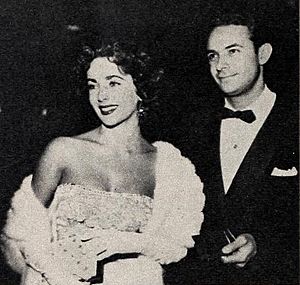
Now a successful director, Donen continued his solo career at MGM with Fearless Fagan (1952), a true story about a soldier and his pet lion. His musical Give a Girl a Break (1953) starred Debbie Reynolds and Marge Champion as dancers trying to get a lead role. The "Give a Girl a Break" dance between Reynolds and Bob Fosse was filmed backwards and then played in reverse to create a cool effect with balloons. The film wasn't well-received at first, but its reputation has grown over time.
Donen had another big hit with the musical Seven Brides for Seven Brothers (1954). The film is known for its amazing dance scenes, especially the "barn raising scene" where building a barn becomes an acrobatic ballet. Seven Brides for Seven Brothers was one of the highest-earning films of 1954. It was nominated for five Academy Awards, winning one for its music. Its success was a surprise to MGM and was a major turning point for Donen's career.
Donen's third and final movie with Gene Kelly as co-director was It's Always Fair Weather (1955). This musical was about three former soldiers who reunite 10 years after World War II. Donen and Kelly's friendship became difficult during the making of this film. Donen called it a "nightmare" and a "struggle from beginning to end." The movie was moderately successful, but not as big a hit as their previous two. This was Donen's last film with Kelly or producer Arthur Freed. After this, he left MGM to work independently.
Independent Director and Producer
Donen's next film was Funny Face (1957) at Paramount Pictures. It starred Fred Astaire and Audrey Hepburn. Astaire plays a fashion photographer who discovers the smart and unique Hepburn in a bookstore and turns her into a model in Paris. Donen, the film's visual consultant Richard Avedon, and the camera director worked together to give the film a dreamy, artistic look, like fashion photos of the time. Funny Face was well-received by critics.
Donen also co-directed The Pajama Game (1957) with his old boss George Abbott. This musical starred Doris Day and John Raitt and featured dances by Bob Fosse. It was a modest success.
After these films, Donen became an independent producer and director. This meant he could choose his own projects and make his own decisions, rather than being tied to one studio. He formed a company with Cary Grant and they made Indiscreet (1958), starring Grant and Ingrid Bergman. This film was a financial and critical success.
Donen briefly returned to musicals with Damn Yankees! (1958), again co-directing with George Abbott. This movie was about a baseball fan who sells his soul to the Devil to help his favorite team win. It was a moderate success and Donen's last musical film until 1974.
Moving to the United Kingdom
After Indiscreet, Donen moved to England and lived there until the early 1970s. As musicals became less popular, he started focusing on comedy films. He felt that being in London helped him stay away from the busy Hollywood scene and allowed him to be more creative.
One of Donen's most praised films was Charade (1963), starring Cary Grant, Audrey Hepburn, Walter Matthau, and James Coburn. Donen said he always wanted to make a movie like Alfred Hitchcock's thrillers. Charade is a fun mix of romance and mystery. Hepburn's character discovers her husband has been murdered, and several dangerous men are looking for money he hid. Grant's character helps her, and they fall in love. The film was a huge financial success and influenced many romantic thrillers that came after it. Critics loved its style and humor.
Donen made another thriller, Arabesque (1966), starring Gregory Peck and Sophia Loren. Peck plays an American professor who gets involved in a mystery involving ancient codes and a plot to assassinate a prime minister. This was Donen's second hit in a row.
Donen then made Two for the Road (1967), starring Audrey Hepburn and Albert Finney. This film tells the story of a 12-year relationship between a couple through different road trips they take in France. It's known for its unique, non-linear storytelling.
He also directed Bedazzled (1967), a funny, updated version of the old story of Faust, where someone makes a deal with the Devil. It starred Peter Cook and Dudley Moore. The film was a hit, especially with college students. Donen considered it one of his favorite films because it allowed him to express what he thought was important in life.
His film Staircase (1969) starred Rex Harrison and Richard Burton as a middle-aged gay couple running a barber shop in London. The film was not a financial success at the time, but some critics have since praised it for showing a gay relationship with wisdom and humor.
Later Works
After his third marriage ended, Donen moved back to Hollywood in 1970. He directed The Little Prince (1974), based on the famous children's book. It was filmed in Tunisia and starred Steven Warner as the Little Prince, with Richard Kiley, Bob Fosse, and Gene Wilder. This was Donen's first musical film in a long time. While it had little dancing, Bob Fosse choreographed his own scenes as the snake. The movie was not a financial success.
Donen's next film was Lucky Lady (1975), starring Liza Minnelli, Gene Hackman, and Burt Reynolds. He then made Movie Movie (1978), which was actually two shorter films presented as an old-fashioned double feature. It was a tribute to old Hollywood movies, including boxing films and extravagant musicals like those by Busby Berkeley. Like his previous two films, it was not very successful.
Donen directed the science fiction film Saturn 3 (1980), starring Kirk Douglas, Farrah Fawcett, and Harvey Keitel. It was a critical and financial failure.
His last movie for theaters was Blame It on Rio (1984). It was filmed in Rio de Janeiro and starred Michael Caine and Demi Moore. It received poor reviews but was a modest financial success.
In 1986, Donen produced the 58th Academy Awards ceremony. He also directed a musical scene for the TV show Moonlighting and the music video for Lionel Richie's song "Dancing on the Ceiling". For the music video, he used the same rotating-room camera trick he used in Royal Wedding. In 1989, Donen received an honorary degree from the University of South Carolina. He even tap-danced for the graduates!
In 1993, Donen directed a stage musical called The Red Shoes, but it closed after only four days. His last film was the TV movie Love Letters (1999), based on a play. It starred Steven Weber and Laura Linney. In 2004, he received the Career Golden Lion award at the 61st Venice International Film Festival.
How He Changed Movies
Cine-Dance
Stanley Donen made many popular and praised films. His most important contribution was helping to change movie musicals. He moved them from looking like filmed stage plays to a more cinematic style. This new style, called "cine-dance," blended dancing and filmmaking in a way that had never been done before. It meant that the dances could only be created using movie cameras and editing.
Before Donen and Kelly, many musicals, like 42nd Street, were called "backstage musicals." In these, the story was about putting on a show, and the musical numbers were part of that stage show. Donen disliked these. He wanted to make musicals where the songs and dances felt like a natural part of the story, not just something added on. He believed that the producer, Arthur Freed, had an instinct to change musicals from being "backstage" to something else. Gene Kelly also said that Donen was the only person he knew who understood how musicals could get better for the movie screen.
New Techniques
Donen and Kelly's films set new standards for special effects, animation, editing, and camera work. Their first collaboration, Cover Girl, showed their new ideas, especially in the "Alter Ego" dance. This scene used a special effect that could only be done in a movie, and it also helped tell the story and show the character's feelings. In Anchors Aweigh, they pushed the limits of film by having Kelly dance with Jerry the Mouse, one of the first times a real person danced with a cartoon character.
By the time they made Take Me Out to the Ball Game, they had perfected a style that focused more on comedy, how songs fit into the story, and the personalities of the stars. This was different from the big, flashy shows of other directors. Donen and Kelly made musicals feel more real.
When On the Town was released, they started the film with a huge musical number filmed in New York City. It had fast editing and experimental camera work, breaking from the usual ways movies were made then. Their most famous film, Singin' in the Rain, is even about the birth of the movie musical. Donen said they were "making fun" of the older, flashy musical styles in some scenes.
Film experts say that Singin' in the Rain's camera work helps the audience feel like they are dancing along with the characters. The famous title number, where Kelly dances in the rain, is a great example. Even though it's not a technically difficult dance, the feeling of swinging an umbrella and the camera pulling back high above Kelly creates a dizzying, joyful effect. Donen also used specific camera techniques, like moving the camera forward to show the end of one shot and the start of another.
Working with Gene Kelly
Donen's relationship with Gene Kelly was complicated. Donen often spoke about it years later, sometimes with bitterness. Kelly, on the other hand, was never openly negative about Donen. Some people say Kelly's comments sometimes made Donen's contributions seem less important. Their disagreements were both personal (both men married the dancer Jeanne Coyne) and professional. Donen felt Kelly didn't treat him as an equal. They worked together on three films as co-directors and four as co-choreographers.
Jeanne Coyne
Jeanne Coyne was a dancer who met Donen and Kelly while working on Broadway. She and Donen got married in 1948 but divorced in 1951. She later married Gene Kelly in 1960.
Professional Disagreements
Many people thought Donen owed his career to Kelly. Kelly described Donen as being like a son to him. Donen initially looked up to Kelly but also found him "cold, egotistical and very rough." Donen said Kelly helped start his career as a filmmaker, but he felt producer Roger Edens was his biggest supporter.
Kelly sometimes embarrassed Donen in public, like when he scolded him for not keeping up with dance steps during rehearsals. Donen admitted he wasn't a great performer himself. Even though Donen started to feel resentful towards Kelly, he kept his feelings private during their early work together. But tensions exploded on the set of It's Always Fair Weather. Donen had just had hits with Deep in My Heart and Seven Brides for Seven Brothers and didn't want to make another film with Kelly. They fought on set for the first time, and their friendship ended.
Donen often complained that Kelly never gave him enough credit for their shared work. Kelly did credit Donen for the Jerry the Mouse and "Alter Ego" dance scenes. In 1992, Donen said, "I'm grateful to him, but I paid back the debt, ten times over."
Directing Styles Compared
Film critics have debated who contributed more to their joint films. Some say that Donen's later solo films show that he was the one who brought the exciting camera work to their musicals. Donen himself said that after working on a scene many times, it's hard to remember who came up with what idea.
However, many people who worked on Singin' in the Rain said that Gene Kelly was in charge. The art director said, "Gene ran the show. Stan had some good ideas and worked with Gene, but he was still the 'office boy' to Gene."
When comparing Donen and Kelly's films as solo directors, Donen's movies were usually more praised by critics and earned more money than Kelly's. Some even say Kelly's film Hello, Dolly! (1969) effectively ended the era of big Hollywood musicals.
Personal Life
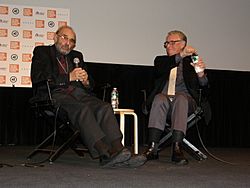
Stanley Donen was married and divorced five times and had three children. His first wife was dancer Jeanne Coyne. They were married from 1948 to 1951. His second wife was actress Marion Marshall. They had two sons, Peter (born 1953) and Joshua (born 1955). The names Peter and Joshua were combined to create the name for Cary Grant's character in Donen's 1963 movie Charade. Donen and Marshall were married from 1952 to 1959. They had disagreements about where their children would live after Marshall married another actor and Donen moved to England.
Donen's third wife was Adelle, Countess Beatty. They married in 1960 and had one son, Mark (born 1962). They lived in London and divorced in 1971. His fourth wife was American actress Yvette Mimieux. They were married from 1972 to 1985 and remained good friends after their divorce. Donen's fifth wife was Pamela Braden. They were married from 1990 to 1994.
In his later years, Donen's partner was writer and director Elaine May. They were together from 1999 until his death. Donen said he proposed to her "about 172 times."
Donen's oldest son, Peter Donen, was a visual effects artist who worked on many films. He died in 2003 at age 50. His second son, Joshua Donen, is a film producer. His third son, Mark Donen, worked as a production assistant.
Stanley Donen's father died in 1959, and his mother died in 1989.
With the deaths of other famous directors in the 2000s, Donen became the last surviving notable film director from Hollywood's "Golden Age" (a time when many classic movies were made). In his final years, he sometimes appeared at film festivals and continued to think about new movie ideas. A documentary about him, Stanley Donen: You Just Do It, was released in 2010.
In 2013, it was announced that Donen was working on a new film with Elaine May. In 2014, to celebrate his 90th birthday, a special event called "A Lotta Talent and a Little Luck: A Celebration of Stanley Donen" was held in his hometown of Columbia, South Carolina. It included a tour of his childhood neighborhood and movie screenings.
Stanley Donen passed away on February 21, 2019, at the age of 94, from heart failure in New York City. He is survived by Elaine May, two sons, and his sister.
Filmography
Selected Films Directed by Stanley Donen
| Year | Title | Director | Producer | Notes |
|---|---|---|---|---|
| 1949 | On the Town | Yes | No | co-directed with Gene Kelly |
| 1951 | Royal Wedding | Yes | No | |
| 1952 | Singin' in the Rain | Yes | No | co-director with Gene Kelly |
| 1954 | Seven Brides for Seven Brothers | Yes | No | |
| 1955 | It's Always Fair Weather | Yes | No | co-director with Gene Kelly |
| 1957 | Funny Face | Yes | No | |
| 1957 | The Pajama Game | Yes | Yes | co-director with George Abbott |
| 1958 | Indiscreet | Yes | Yes | |
| 1958 | Damn Yankees! | Yes | Yes | co-directed with George Abbott |
| 1963 | Charade | Yes | Yes | |
| 1966 | Arabesque | Yes | Yes | |
| 1967 | Two for the Road | Yes | Yes | |
| 1967 | Bedazzled | Yes | Yes | |
| 1974 | The Little Prince | Yes | Yes | |
| 1978 | Movie Movie | Yes | Yes | |
| 1980 | Saturn 3 | Yes | Yes | |
| 1984 | Blame It on Rio | Yes | Yes | |
| 1999 | Love Letters | Yes | No | Television film |
Honors and Legacy
During his career, Donen was often compared to another famous musical director, Vincente Minnelli. Film critics often preferred Donen's clear, direct style of directing over Minnelli's more artistic and emotional approach. They felt Donen's camera work was better suited for dance scenes.
In 1998, Donen received an Honorary Academy Award for his amazing work in film. Director Martin Scorsese presented the award to him, praising his career and impact. In his acceptance speech, Donen danced with his Oscar statue while singing "Cheek to Cheek", a song made famous by his childhood hero, Fred Astaire.
Film experts like David Thomson praised Donen for bringing musicals "out of doors" and for how well he blended song, dance, and story.
Many famous film directors admired Donen's work, including Woody Allen, Pedro Almodóvar, Stanley Kubrick, Martin Scorsese, and Steven Spielberg. Actors like Cyd Charisse and Audrey Hepburn also praised his directing skills. Donen's work influenced later directors of movie musicals. The 2011 film The Artist even paid tribute to Singin' in the Rain.
Singin' in the Rain is Donen's most celebrated film. It was one of the first films chosen to be part of the National Film Registry at the Library of Congress in 1989, meaning it's considered very important. It has also appeared on prestigious lists of the "Top Ten Films" multiple times. Director Billy Wilder called it "one of the five greatest pictures ever made."
See also
 In Spanish: Stanley Donen para niños
In Spanish: Stanley Donen para niños


